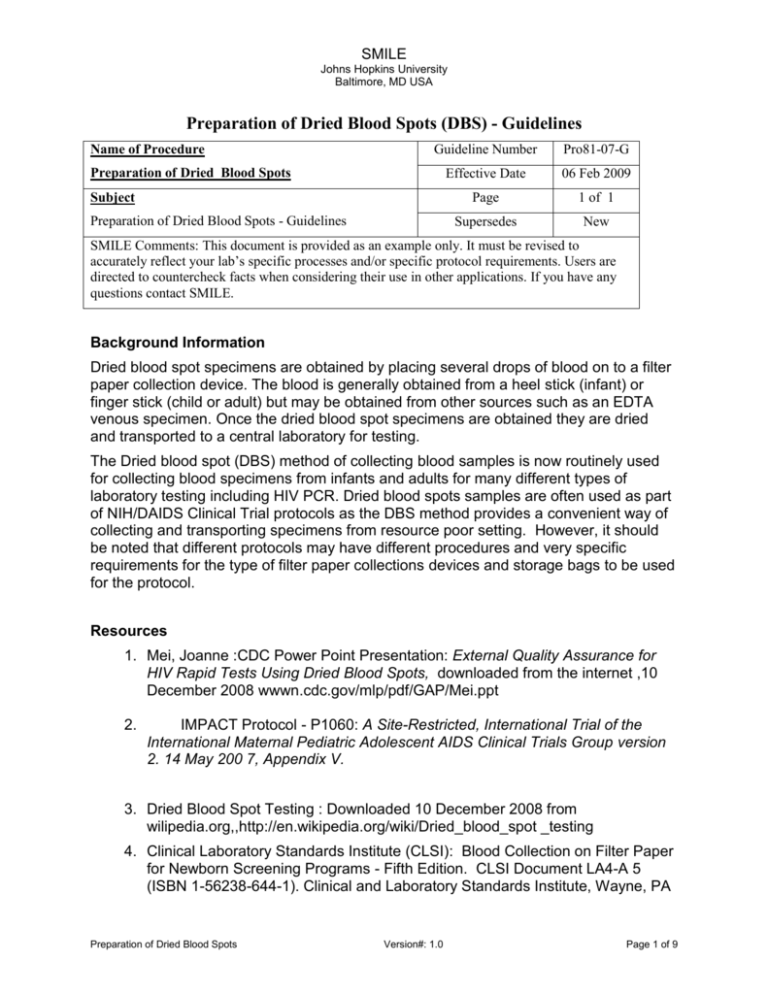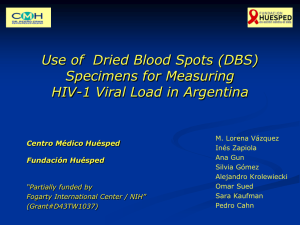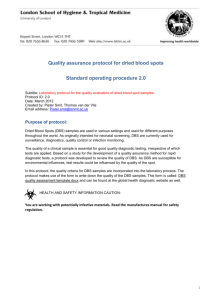Pro81-07_Prep_of_DBS - National Institutes of Health
advertisement

SMILE Johns Hopkins University Baltimore, MD USA Preparation of Dried Blood Spots (DBS) - Guidelines Name of Procedure Guideline Number Pro81-07-G Effective Date 06 Feb 2009 Page 1 of 1 Supersedes New Preparation of Dried Blood Spots Subject Preparation of Dried Blood Spots - Guidelines SMILE Comments: This document is provided as an example only. It must be revised to accurately reflect your lab’s specific processes and/or specific protocol requirements. Users are directed to countercheck facts when considering their use in other applications. If you have any questions contact SMILE. Background Information Dried blood spot specimens are obtained by placing several drops of blood on to a filter paper collection device. The blood is generally obtained from a heel stick (infant) or finger stick (child or adult) but may be obtained from other sources such as an EDTA venous specimen. Once the dried blood spot specimens are obtained they are dried and transported to a central laboratory for testing. The Dried blood spot (DBS) method of collecting blood samples is now routinely used for collecting blood specimens from infants and adults for many different types of laboratory testing including HIV PCR. Dried blood spots samples are often used as part of NIH/DAIDS Clinical Trial protocols as the DBS method provides a convenient way of collecting and transporting specimens from resource poor setting. However, it should be noted that different protocols may have different procedures and very specific requirements for the type of filter paper collections devices and storage bags to be used for the protocol. Resources 1. Mei, Joanne :CDC Power Point Presentation: External Quality Assurance for HIV Rapid Tests Using Dried Blood Spots, downloaded from the internet ,10 December 2008 wwwn.cdc.gov/mlp/pdf/GAP/Mei.ppt 2. IMPACT Protocol - P1060: A Site-Restricted, International Trial of the International Maternal Pediatric Adolescent AIDS Clinical Trials Group version 2. 14 May 200 7, Appendix V. 3. Dried Blood Spot Testing : Downloaded 10 December 2008 from wilipedia.org,,http://en.wikipedia.org/wiki/Dried_blood_spot _testing 4. Clinical Laboratory Standards Institute (CLSI): Blood Collection on Filter Paper for Newborn Screening Programs - Fifth Edition. CLSI Document LA4-A 5 (ISBN 1-56238-644-1). Clinical and Laboratory Standards Institute, Wayne, PA Preparation of Dried Blood Spots Version#: 1.0 Page 1 of 9 SMILE Johns Hopkins University Baltimore, MD USA Preparation of Dried Blood Spots Author(s), Name & Title Jo Shim MBA, MT(ASCP) Document Number Effective Date Pro81-07-SOP 06 Feb 2009 SMILE Comments: This document is provided as an example only. It must be revised to accurately reflect your lab’s specific processes and/or specific protocol requirements. Users are directed to countercheck facts when considering their use in other applications. If you have any questions contact SMILE. Name, Title Approved By Signature Date Signature Date Penny Stevens Name, Title SOP Annual Review Version # [0.0] Revision Date [dd/mm/yy] Description (notes) Revision History Name (or location) # of copies Name (or location) # of copies Distributed Copies to Associated Forms: Preparation of Dried Blood Spots Version#: 1.0 Page 2 of 9 SMILE Johns Hopkins University Baltimore, MD USA I acknowledge that I have read, understand and agree to follow this SOP. Name (print) Preparation of Dried Blood Spots Signature Version#: 1.0 Date Page 3 of 9 SMILE Johns Hopkins University Baltimore, MD USA Purpose This procedure provides general instructions for the preparations, collection and preservation of dried blood spot (DBS) specimens obtained from heel sticks and venous blood draws. Scope The collection of blood using dried blood spots is applicable for many types or testing and particularly useful for screening tests for newborns and pediatric patients. DBS specimens are required for many NIH/DAIDS HIV Clinical Drug Trials. Responsibility Lab Director Laboratory Supervisor All Laboratory technologists, technicians and phlebotomists trained to prepare dried blood spots. Definitions DBS –Dried Blood Spots DAIDS- Division of AIDS NIH-National Institutes of Health Safety precautions It is essential that Standard Precautions be followed while working with DBS specimens. Laboratory staff involved in obtaining DBS specimens should use appropriate personal protective equipment in accordance with the safety procedure followed at [your laboratory]. For safety reasons, glass capillary tubes are not recommended for collecting blood for DBS testing. Procedure General Instructions 1. For DAIDS HIV network clinical trials, prepare dried blood spot (DBS) cards as specified by specific protocol standards. 2. Ensure that the filter paper collection devices to be used have not expired. 3. Fill out the DBS card with the required patient information. 4. Prepare to fill the DBS cards by one of the following methods: a. Blood drawn in an EDTA (purple top) tube b. Performing a heel stick (infant) c. Performing a finger stick (Child or adult) 5. Other specimens may be used such as cord blood but these are generally not recommended for DAIDS/sponsored HIV clinical trials. 6. The DBS filter cards come with printed circles. Always apply blood to the inside of the circles and fill the entire circle with blood. Preparation of Dried Blood Spots Version#: 1.0 Page 4 of 9 SMILE Johns Hopkins University Baltimore, MD USA 7. Apply blood to only one side of the filter paper (the side with the printing). An Example of a Filter Paper Collection Device Place label here Date of Sample Collection: _____________________ Type of Visit: ________________________________ Causes for Sample Rejection 1. Failure to wipe off alcohol residue as this may dilute the specimen and adversely affect test results. 2. Milking or squeezing the puncture may cause hemolysis and will add a mixure of tissue fluids with specimen 3. Use of a capillary tube to apply the specimen to the card. Application of blood with a capillary tube results in scratching of the surface of the filter paper and may adversely affect the results. 4. Layering or applying more than one layer of blood onto the filter paper collection device may also cause failure. This practice causes uneven distribution of analytes and may invalidate the specimen. 5. Failure to collect the required # if blood spots can also invalidated a specimen. 6. Touching the area inside the filter paper circles before the blood is applied. 7. Insufficient drying before placing the specimen in the designated storage bag. 8. See Appendix A (page 9) for examples of correctly and incorrectly collected DBS specimens. Preparation of Dried Blood Spots Version#: 1.0 Page 5 of 9 SMILE Johns Hopkins University Baltimore, MD USA Preparation of DBS Using a Heel stick Specimen Equipment Needed: 1. 2. 3. 4. 5. 6. Heel stick blood draw apparatus Alcohol swab dry sterile gauze pad Filter paper collection device Plastic storage bag Desiccant pack Procedure: 1. Prepare infant’s heel for a heel stick blood draw according to the established procedure [provide reference to your lab’s phlebotomy, specimen management or other appropriate SOP]. 2. Following the performance of the heel stick, use a sterile gauze pad to wipe away the first drop of blood. The blood is then allowed to flow and large drop should form prior to blood collection. 3. Collect the blood on the designated filer paper collection device by gently touching the filter paper to the blood drop. Allow a sufficient quantity of blood soak through and fill each circle. Do not press the filter paper against the puncture site on the heel. 4. If you need to obtain more blood gently squeeze the infant’s heel but do not “milk the heel as this has the effect of mixing interstitial fluid with the blood 5. Once the required number of blood spots are obtained raise the infant’s leg and, bandage the heel according the established procedure [for your lab]. 6. Do not touch the DBS circle once blood is applied. 7. The DBS filter paper collection device should be placed in a horizontal position and allowed to air dry in a clean dry place that is protected from rodents and insects for at least 4 hours (over night may be necessary in areas with higher humidity). The DBS collection device should then be placed in a storage bag. The type of plastic bag will be designated by the protocol. 8. General recommendations for DBS storage indicate that DBS specimens should not be stored airtight leak-proof bags such as plastic or foil bags. The lack of air exchange in airtight bags may lead to heat build-up and moisture collection which may be detrimental to the DBS specimens. 9. Dry thoroughly before enclosing in storage bag. Desiccant packs should be added to the selected storage bags to prevent the accumulation of moisture. Protocol participants should follow the instructions for DBS storage provided in specific protocols. Preparation of Dried Blood Spots Version#: 1.0 Page 6 of 9 SMILE Johns Hopkins University Baltimore, MD USA 10. For NIH/DAIDS studies store no more than one card per storage bag. Once in the bag, DBS specimens can be stored at room temperature until ready for processing or shipping. Preparation of DBS Using Venous Blood Collected in EDTA Tube Equipment Needed: 1. Vacationer Evacuated Blood Collection Tubes. These tubes are designed to be filled with a predetermined volume of blood by vacuum. The rubber stoppers are color-coded according to the additive that the tube contains. Total volume required per card will be 250 micro liters to fill five spots each at 50 microliters per spot. Under no circumstances should these purple top tubes be placed in the refrigerator. 2. Alcohol swab 3. Tourniquet 4. Bandage/Plaster 5. Vacutainer Needle 6. Vacutainer Needle Holder 7. Filter paper collection device 8. Storage bag 9. Desiccant pack Procedure: 1. Draw an EDTA tube following the established procedure for venipuncture. Fill the EDTA blood collection tube to the recommended volume so that the anticoagulant is at the proper dilution. 2. Gently invert the tube (5-10 times) to mix the blood thoroughly. 3. After the blood is completely mixed, remove the cap, and using a 50uL micro pipette and a new tip transfer 50 microliters of whole blood and apply to a single spot on the designated filter paper collection device. 4. This transfer of blood should be performed with a micropipette and a disposable tip. Care should be taken not touch the DBS circle once blood is applied. 5. Place the blood spot collection device in a horizontal position. It should be allowed to air dry in a clean dry place that is protected from rodents or insects. The DBS card should be dried for at least 4 hours (over night may be necessary in areas with higher humidity). 6. General recommendations for DBS storage indicate that DBS specimens should not be stored airtight leak-proof bags such as plastic or foil bags. The lack of air exchange in airtight bags may lead to heat build-up and moisture collection which may be detrimental to the DBS specimens. 7. Dry thoroughly before enclosing in storage bag. Desiccant packs should be added to the selected storage bags to prevent the accumulation of moisture. Protocol participants should follow the instructions for DBS storage provided in specific protocols. Preparation of Dried Blood Spots Version#: 1.0 Page 7 of 9 SMILE Johns Hopkins University Baltimore, MD USA 8. For NIH/DAIDS studies store no more than one card per storage bag. Once in the bag, DBS specimens can be stored at room temperature until ready for processing or shipping. References 1. Mei, Joanne :CDC Power Point Presentation: External Quality Assurance for HIV Rapid Tests Using Dried Blood Spots, downloaded from the internet ,10 December 2008 wwwn.cdc.gov/mlp/pdf/GAP/Mei.ppt 2. IMPACT Protocol - P1060: A Site-Restricted, International Trial of the International Maternal Pediatric Adolescent AIDS Clinical Trials Group version 2. 14 May 200 7, Appendix V. 3. Dried Blood Spot Testing : Downloaded 10 December 2008 from wilipedia.org,,http://en.wikipedia.org/wiki/Dried_blood_spot _testing 4. Clinical Laboratory Standards Institute (CLSI): Blood Collection on Filter Paper for Newborn Screening Programs - Fifth Edition. CLSI Document LA4-A 5 (ISBN 1-56238-644-1). Clinical and Laboratory Standards Institute, Wayne, PA Appendices: 1. Appendix A : Dried Blood Spot Collection Examples Preparation of Dried Blood Spots Version#: 1.0 Page 8 of 9 SMILE Johns Hopkins University Baltimore, MD USA Appendix A – DBS Collection Examples Preparation of Dried Blood Spots Version#: 1.0 Page 9 of 9



